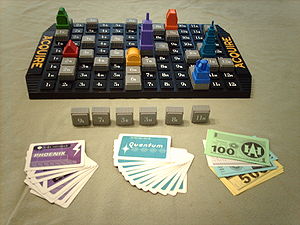Acquire
| Acquire | |
|---|---|
 Material from Acquire |
|
| Game data | |
| author | Sid Sackson |
| publishing company |
3M (1962, 1968) Schmidt Spiele (1968, 1982, 1993, 1997) Avalon Hill (1971), Avalon Hill / Hasbro (2000), u. a. |
| Publishing year | 1962 |
| Art | Board game |
| Teammates | 2 to 6 |
| Duration | 90 minutes |
| Age | from 12 years
|
| Awards | |
|
Game of the Year 1979: Selection list |
|
Acquire (English: acquire ) is a classic board game by game designer Sid Sackson . It is an economic strategy game in which players earn money by buying and selling stocks related to starting hotel chains.
Acquire was first published in the US in 1962 by 3M Company . In the meantime there have been various new editions, including various ones in German . In Germany it was published by Schmidt Spiele under the titles Hotel-Haie and Hotel-König (1982).
regulate
Two to six players can take part in the game. One player takes over the stock exchange and handles all stock exchange transactions, such as buying shares. Each player receives a certain starting capital (depending on the number of participants) and an information card.
The game board is divided into 9 × 12 fields, which are clearly identified by numbers and letters. Next to it, back side up, lie 108 stones that are assigned to the fields. They represent the hotels. Each player draws six stones at the beginning. A move consists of placing a stone on the field assigned to it, executing any actions that may be triggered, buying shares and drawing them. Make sure that ( similar to the domino game ) horizontally and vertically stones are next to each other, because this creates hotel chains (a maximum of 7 different with different starting prices) whose shares (25 per hotel chain) increase in value. If a stone touches another chain, they merge and the majority shareholders of the smaller chain are financially compensated. Each shareholder in the smaller chain can then decide whether to sell their shares at the last valid price, exchange them 2: 1 for shares in the larger chain, or keep them. In the end, after the majority bonuses have been paid out and the shares sold, the winner is the player with the most money.
Web links
- Acquire in the games database BoardGameGeek (English)
- Acquire (1962, 3M) in the Luding games database
- Acquire (1968, 3M) in the Luding games database
- Hotel-König (1968, Schmidt Spiele) in the Luding games database
- Acquire (2000, Avalon Hill) in the Luding games database